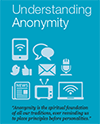Traditionally, AA members have always taken care to preserve their anonymity at the “public” level: press, radio, television, and films; today this extends to the Internet and digital technologies. In 2013 the General Service Conference affirmed “ . . . that the Internet, social media and all forms of public communications are implicit in the last phrase of the Short Form of Tradition Eleven, which reads: ‘ . . . at the level of press, radio and films.’”
In the early days of AA, when more stigma was attached to the term “alcoholic” than is the case today, this reluctance to be identified — and publicized — was easy to understand. We know from experience that many problem drinkers might hesitate to turn to AA for help if they thought their problem might be discussed publicly, even inadvertently, by others. Newcomers should be able to seek help with assurance that their identities will not be disclosed to anyone outside the Fellowship.
Anonymity serves two different yet equally vital functions:
- At the personal level, anonymity provides protection for all members from identification as alcoholics, a safeguard often of special importance to newcomers.
- At the public level of press, radio, TV, films and other media technologies such as the Internet, anonymity stresses the equality in the Fellowship of all members by putting the brake on those who might otherwise exploit their AA affiliation to achieve recognition, power, or personal gain.
Facebook and Other Social Media
When using digital media, AA members are responsible for their own anonymity and that of others. When we post, text, or blog, we should assume that we are publishing at the public level. When we break our anonymity in these forums, we may inadvertently break the anonymity of others.
Facebook and other social networking websites are public in nature. Though users create accounts and utilize usernames and passwords, once on the site, it is a public medium where AA members and non-AAs mingle. The platforms in and of themselves do not infringe on our principles of anonymity or any other Traditions. It is the actions of the individual that may cause harm to themselves, to others, or to A.A. as a whole.
As long as individuals do not identify themselves as AA members, there is no conflict of interest. Even “closed” or “private” groups might still reveal an individual’s identity, so being well informed prior to joining or starting such a group is the key to protecting your own anonymity, and that of others.
A.A Guidelines Published by the General Service Office
A.A. Guidelines are compiled from the shared experience of A.A. members in various service areas. They also reflect guidance given through the Twelve Traditions and the General Service Conference (U.S. and Canada). In keeping with our Tradition of autonomy, except in matters affecting other groups or A.A. as a whole, most decisions are made by the group conscience of the members involved. The purpose of these Guidelines is to assist in reaching an informed group conscience.
Understanding Anonymity – For a printable PDF version of the pamphlet click the image below:
* Source: content in this post was retrieved from https://aa.org on November 14th, 2019


